ZHCSNB0E February 2021 – May 2025 AFE7950
PRODUCTION DATA
- 1
- 1特性
- 2应用
- 3说明
-
4规格
- 4.1 绝对最大额定值
- 4.2 ESD 等级
- 4.3 建议运行条件
- 4.4 热性能信息
- 4.5 发送器电气特性
- 4.6 射频 ADC 电气特性
- 4.7 PLL/VCO/时钟电气特性
- 4.8 数字电气特性
- 4.9 电源电气特性
- 4.10 时序要求
- 4.11 开关特性
- 4.12
典型特性
- 4.12.1 800 MHz 下的 TX 典型特性
- 4.12.2 1.8 GHz 下的 TX 典型特性
- 4.12.3 2.6 GHz 下的 TX 典型特性
- 4.12.4 3.5 GHz 下的 TX 典型特性
- 4.12.5 4.9 GHz 下的 TX 典型特性
- 4.12.6 8.1 GHz 下的 TX 典型特性
- 4.12.7 9.6 GHz 下的 TX 典型特性
- 4.12.8 800 MHz 下的 RX 典型特性
- 4.12.9 1.75GHz 至 1.9GHz 下的 RX 典型特性
- 4.12.10 2.6 GHz 下的 RX 典型特性
- 4.12.11 3.5 GHz 下的 RX 典型特性
- 4.12.12 4.9 GHz 下的 RX 典型特性
- 4.12.13 8.1 GHz 下的 RX 典型特性
- 4.12.14 9.6 GHz 下的 RX 典型特性
- 4.12.15 PLL 和时钟典型特性
- 5修订历史记录
- 6器件和文档支持
- 7机械、封装和可订购信息
封装选项
机械数据 (封装 | 引脚)
散热焊盘机械数据 (封装 | 引脚)
订购信息
4.12.8 800 MHz 下的 RX 典型特性
TA = +25°C 且 ADC 采样率 = 2949.12GHz 时的典型值。默认条件:输出采样率 = 491.52MSPS(抽取因子为 6),PLL 时钟模式,其中 fREF = 491.52MHz,AIN = –3dBFS,DSA 设置 = 4dB。
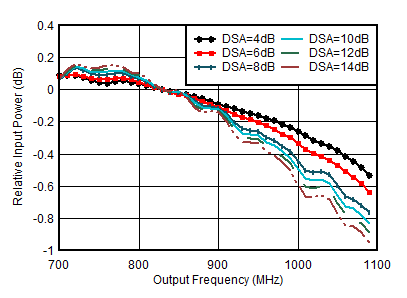
| 使用 0.8GHz 匹配时,标准化为 830MHz | ||

| 使用 0.8GHz 匹配时,标准化为 25°C 时的相位 | ||

| 使用 0.8GHz 匹配 | ||
| 差分振幅误差 = PIN(DSA 设置 - 1)- PIN(DSA 设置)+ 1 |
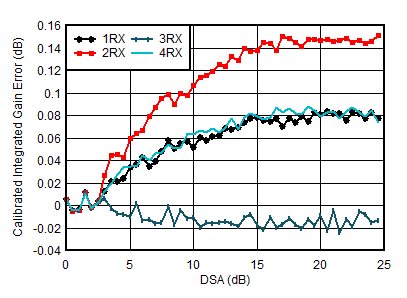
| 使用 0.8GHz 匹配 | ||
| 积分振幅误差 = PIN(DSA 设置)- PIN(DSA 设置 = 0)+(DSA 设置) |
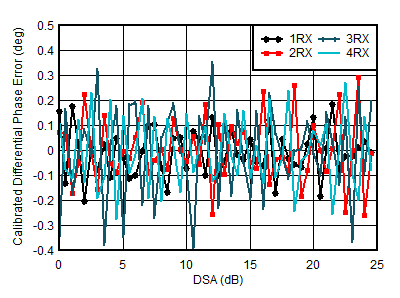
| 使用 0.8GHz 匹配 | ||
| 差分相位误差 = PhaseIN(DSA 设置 - 1)- PhaseIN(DSA 设置) |

| 使用 0.8GHz 匹配 | ||
| 积分相位误差 = Phase(DSA 设置)- Phase(DSA 设置 = 0) |
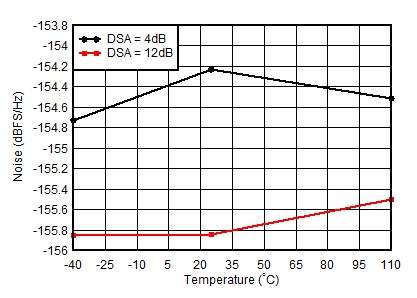
| 使用 0.8GHz 匹配时,偏移频率为 12.5MHz | ||

| 使用 0.8GHz 匹配时,偏移频率为 12.5MHz | ||
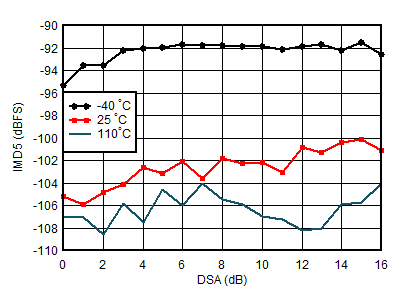
| 使用 0.8GHz 匹配时,单音幅度为 -7dBFS,频率间隔 = 20MHz |

| 使用 0.8GHz 匹配时,频率间隔 = 20MHz,DSA = 12dB |

| 使用 0.8GHz 匹配时,在 HD2 修整后测量,DDC 旁路模式(对于表征,仅 TI 模式) |
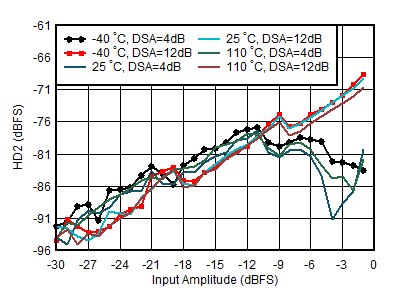
| 使用 0.8GHz 匹配时,在 HD2 修整后测量,DDC 旁路模式(对于表征,仅 TI 模式) |
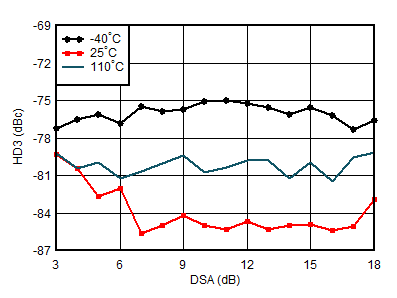
| 使用 0.8GHz 匹配时,DDC 旁路模式(对于表征,仅 TI 模式) |

| 使用 0.8GHz 匹配时,DDC 旁路模式(对于表征,仅 TI 模式) |

| 使用 0.8GHz 匹配时,单音幅度为 -7dBFS,频率间隔为 20MHz,所有电源均处于 MIN、TYP 或 MAX 推荐工作电压 |

| 使用 0.8GHz 匹配时,偏移为 12.5MHz,所有电源均处于 MIN、TYP 或 MAX 推荐工作电压 |
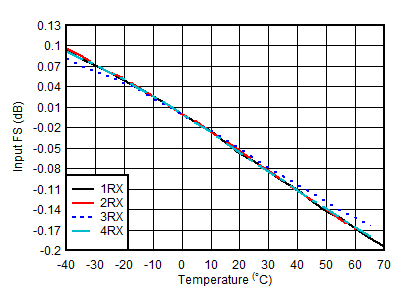
| 使用 0.8GHz 匹配时,为每个通道标准化为 25°C 时的满量程 |
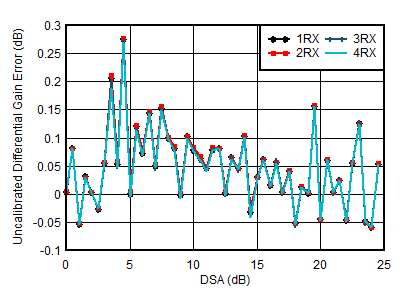
| 使用 0.8GHz 匹配 | ||
| 差分振幅误差 = PIN(DSA 设置 - 1)- PIN(DSA 设置)+ 1 |

| 使用 0.8GHz 匹配 | ||
| 积分振幅误差 = PIN(DSA 设置)- PIN(DSA 设置 = 0)+(DSA 设置) |
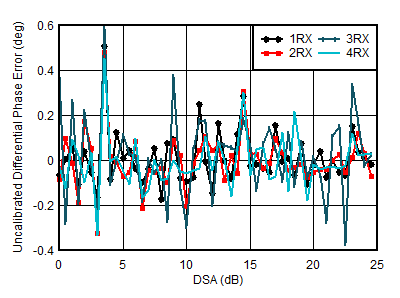
| 使用 0.8GHz 匹配 | ||
| 差分相位误差 = PhaseIN(DSA 设置 - 1)- PhaseIN(DSA 设置) |
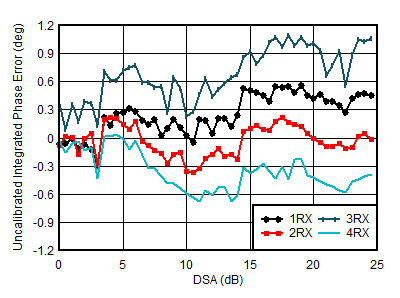
| 使用 0.8GHz 匹配 | ||
| 积分相位误差 = Phase(DSA 设置)- Phase(DSA 设置 = 0) |

| 使用 0.8GHz 匹配时,fIN = 840MHz,AIN = -3dBFS | ||

| 使用 0.8GHz 匹配时,DSA 设置 = 12dB,偏移频率为 12.5MHz | ||

| 使用 0.8GHz 匹配时,单音幅度为 -7dBFS,频率间隔 = 20MHz |

| 使用 0.8GHz 匹配时,频率间隔 = 20MHz,DSA = 4dB | ||

| 使用 0.8GHz 匹配时,频率间隔 = 20MHz,DSA = 12dB |

| 使用 0.8GHz 匹配时,在 HD2 修整后测量,DDC 旁路模式(对于表征,仅 TI 模式) |
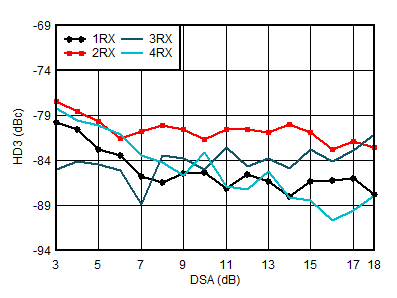
| 使用 0.8GHz 匹配时,DDC 旁路模式(对于表征,仅 TI 模式) |
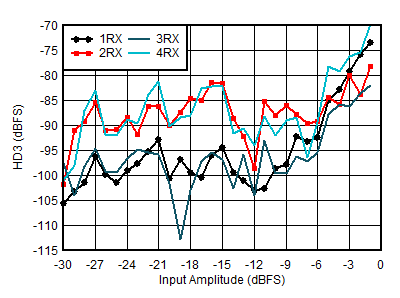
| 使用 0.8GHz 匹配时,DDC 旁路模式(对于表征,仅 TI 模式) |
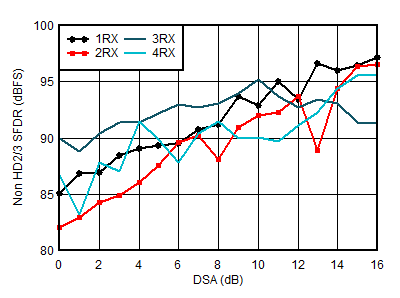
| 使用 0.8GHz 匹配 | ||

| 使用 0.8GHz 匹配时,单音幅度为 -7dBFS,频率间隔为 20MHz,所有电源均处于 MIN、TYP 或 MAX 推荐工作电压 |